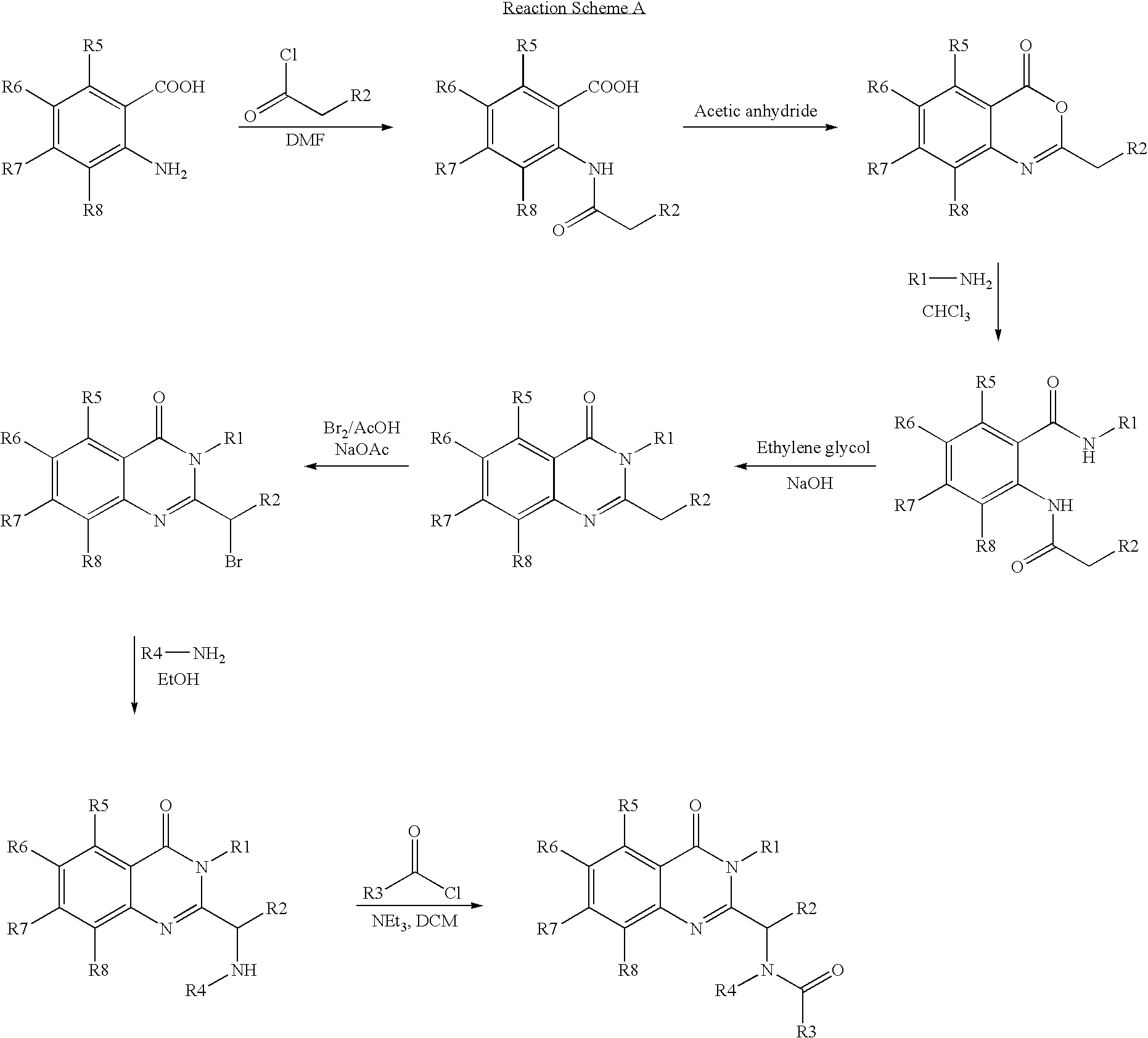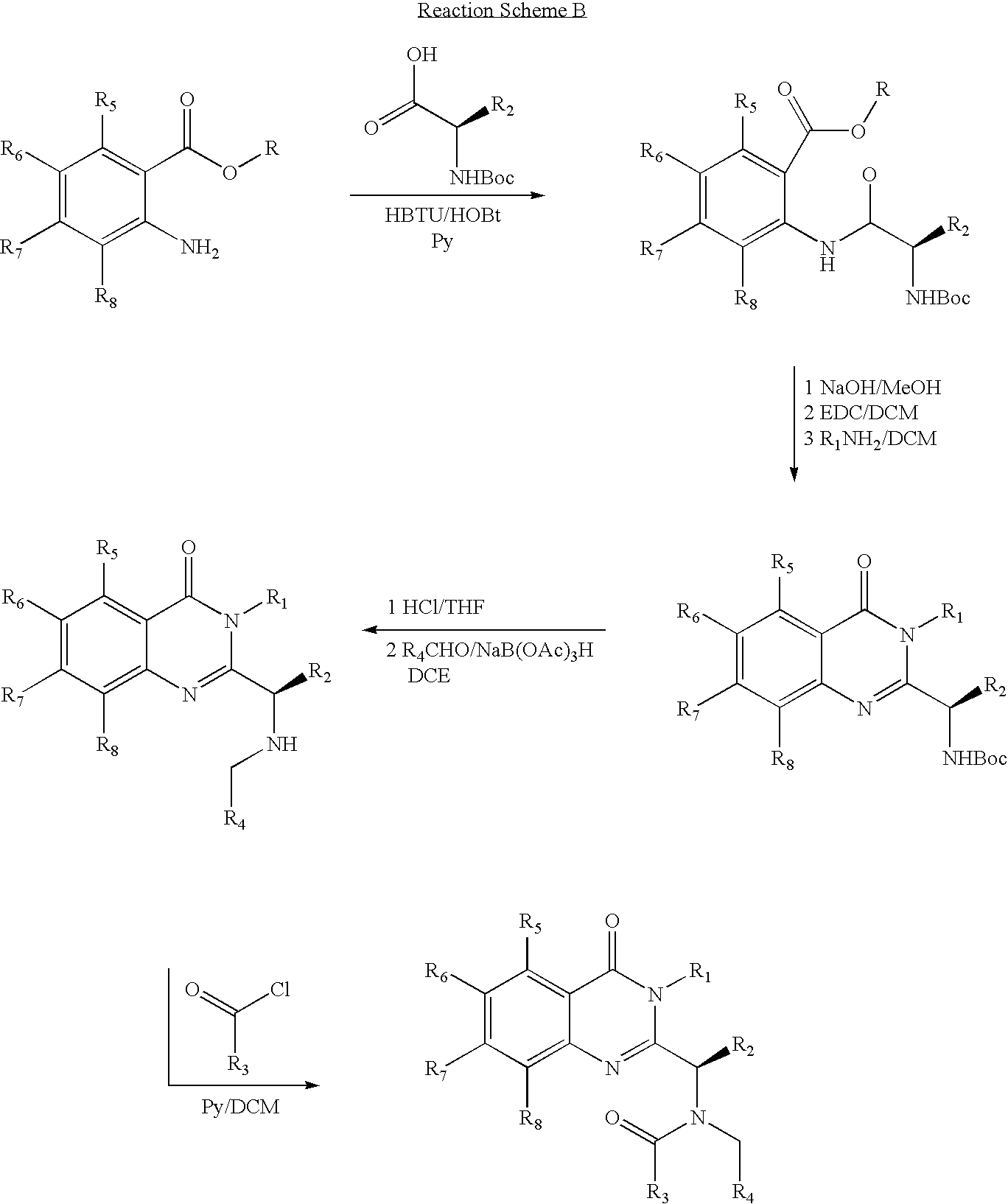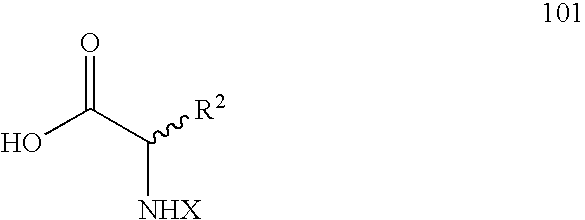Syntheses of quinazolinones
a technology of quinazolinone and quinazolinone, which is applied in the field of synthesis of certain quinazolinone derivatives, can solve the problems of low yield, long prior synthetic approach, and inability to synthesize large-scale batches of compounds,
- Summary
- Abstract
- Description
- Claims
- Application Information
AI Technical Summary
Benefits of technology
Problems solved by technology
Method used
Image
Examples
example 1
Synthesis of (R)-N-(3-Amino-propyl)-N-[1-(3-benzyl-7-chloro-4-oxo-3,4-dihydro-quinalolin-2-yl)-2-methyl-propyl]-4-methyl-benzamide
1.1 7-Chloro-2-isobutyl-benzo[d][1,3]oxazin-4-one
[0156]A dry 3-necked, round bottomed flask, equipped with an overhead stirrer, thermometer, dropping funnel, cooling bath and condenser was charged with 406.41 g of 2-amino-4-chlorobenzoic acid (1 eq.), 270 g (1.35 eq.) of sodium bicarbonate, Na2SO4 (as a dehydrating agent) and 1,000 mL of THF. After commencing agitation, 354.7 g (1.2 eq.) of isovaleryl chloride was added dropwise. The reaction was exothermic and generated a gas (CO2). Temperature was maintained around 20–30° C. and completion of the reaction monitored by TLC (EtOAc / hexanes 1:1). The reaction mixture was then filtered and washed with THF (1,000 mL) the majority of which was then stripped off under vacuum. Acetic anhydride (1,450 mL) was then added to the reaction vessel and the temperature raised to 90–100° C. Completion of the reaction mon...
example 2
Synthesis of (S)-[1-(3-Benzyl-7-chloro-4-oxo-3,4-dihydro-quinazolin-2-yl)-2-methylpropyl]-carbamic acid tert-butyl ester
2.1 Formula 104 where R2 is i-Propyl; R7 is Chloro; and R5, R6 and R8 are H
[0168]A dry 3-necked, round bottomed flask, equipped with a magnetic stirrer, nitrogen inlet and an ice-bath, was charged with 250 mL of anhydrous THF, 22.82 g (0.105 mol) of dry N-Boc-L-valine (Formula 101), and 12.2 mL (0.11 mol) of anhydrous N-methylmorpholine, (99%), and was cooled to 0° C. To the stirring solution was added 14.5 mL (0.11 mol) of isobutyl chloroformate (98%) (Formula 102), over 15 min (internal temperature 5° C.) and the mixture was stirred for additional 1.5 h at 0° C. TLC analysis (hexanes / ethyl acetate 7:3) indicated complete reaction.
[0169]To the above stirring mixture at 0° C., 17.51 g (0.1 mol) of 4-chloro-anthranilic acid (98%) (Formula 103) was added in one portion and the mixture continued to stir for 2 h at 0° C. To the stirring mixture 11.1 mL (0.1 mol) of anh...
example 3
Synthesis of [1-(3-Benzyl-7-chloro-4-oxo-3,4-dihydro-quinazolin-2-yl)-2-methylpropyl]-carbamic acid tert-butyl ester
3.1 Formula 201 where R1 is H; R2 is i-Propyl; R7 is Chloro; and R5, R6 and R8 are H
[0175](S)-[1-(7-Chloro-4-oxo-4H-benzo[d][1,3]oxazin-2-yl-2-methyl-propyl]-carbamic acid tert-butyl ester (a compound of Formula 105) was prepared (e.g., as described in Example 2.2) in a 3-necked, round bottom flask equipped with a magnetic stirrer, nitrogen inlet and an ice bath. A dry-ice condenser was fitted to the reaction flask and to the stirring mixture (at 0° C.) gaseous ammonia was slowly introduced until the resulting exotherm was no longer observed. The mixture was then allowed to stir for 2 h at room temperature and TLC analysis (hexanes / ethyl acetate 7:3) indicated complete reaction. The compound of Formula 105 was consumed and the title compound of Formula 201 was formed. The reaction mixture was then diluted with 250 mL of water, and was transferred into a round bottom 1-...
PUM
| Property | Measurement | Unit |
|---|---|---|
| enantiomeric excess | aaaaa | aaaaa |
| enantiomeric excess | aaaaa | aaaaa |
| enantiomeric excess | aaaaa | aaaaa |
Abstract
Description
Claims
Application Information
 Login to View More
Login to View More - R&D
- Intellectual Property
- Life Sciences
- Materials
- Tech Scout
- Unparalleled Data Quality
- Higher Quality Content
- 60% Fewer Hallucinations
Browse by: Latest US Patents, China's latest patents, Technical Efficacy Thesaurus, Application Domain, Technology Topic, Popular Technical Reports.
© 2025 PatSnap. All rights reserved.Legal|Privacy policy|Modern Slavery Act Transparency Statement|Sitemap|About US| Contact US: help@patsnap.com



